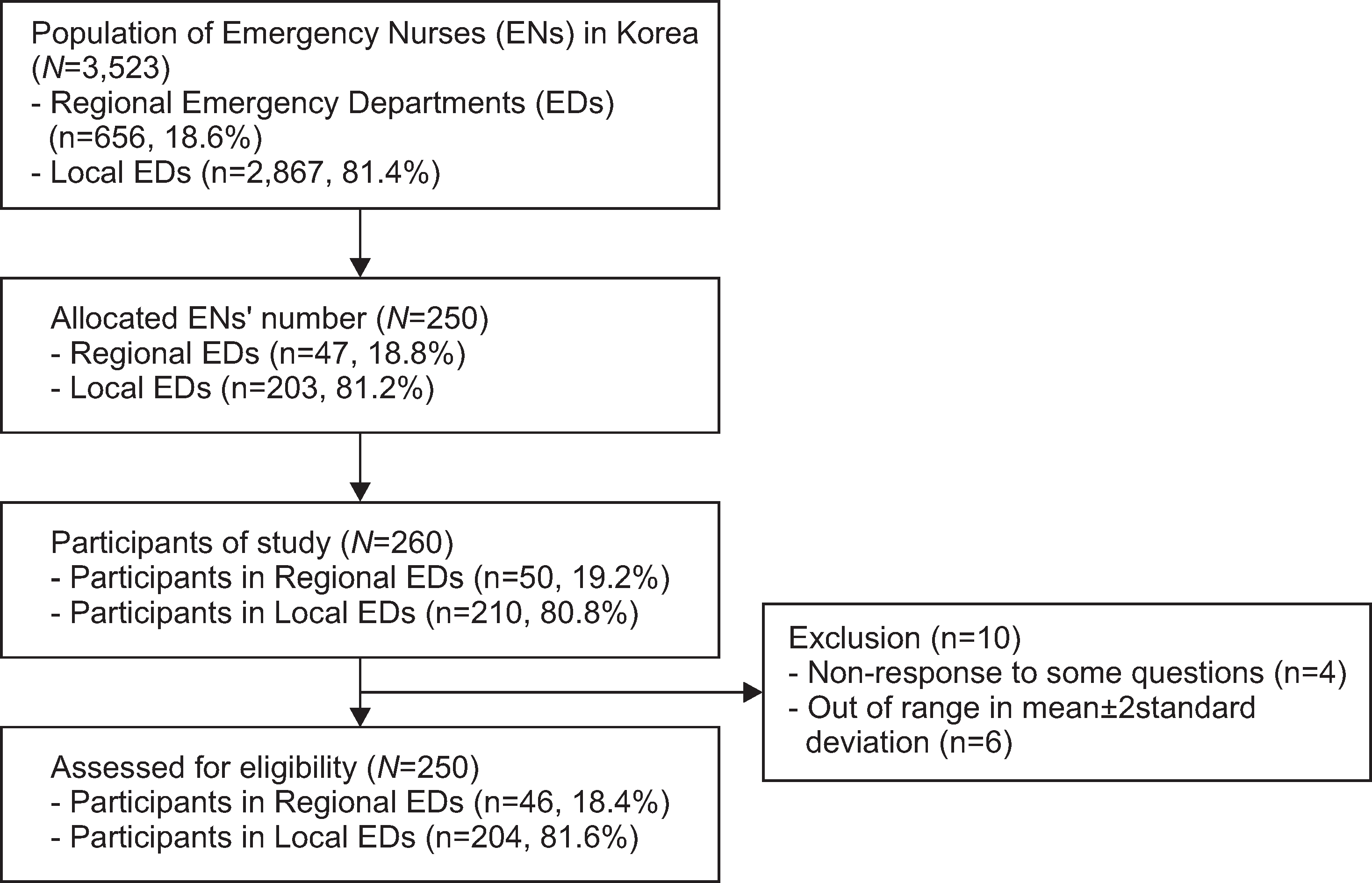Abstract
Purpose
This study aimed to develop a triage competency scale (TCS) for emergency nurses, and to evaluate its validity and reliability.
Methods
Preliminary items were derived based on the attributes and indicators elicited from a concept analysis study on triage competency. Ten experts assessed whether the preliminary items belonged to the construct factor and determined the appropriateness of each item. A revised questionnaire was administered to 250 nurses in 18 emergency departments to evaluate the reliability and validity of the scale. Data analysis comprised item analysis, confirmatory factor analysis, contrasted group validity, and criterion-related validity, including criterion-related validity of the problem solving method using video scenarios.
Results
The item analysis and confirmatory factor analysis yielded 5 factors with 30 items; the fit index of the derived model was good (χ 2/df =2.46, Root Mean squared Residual=.04, Root Mean Squared Error of Approximation=.08). Additionally, contrasted group validity was assessed. Participants were classified as novice, advanced beginner, competent, and proficient, and significant differences were observed in the mean score for each group (F=6.02, p=.001). With reference to criterion-related validity, there was a positive correlation between scores on the TCS and the Clinical Decision Making in Nursing Scale (r=.48, p<.001). Further, the total score on the problem solving method using video scenarios was positively correlated with the TCS score (r=.13, p=.04). The Cronbach's α of the final model was .91.
Go to : 
References
1. Sweet V; Emergency Nurses Association. Emergency nursing core curriculum. 7th ed. St. Louis: Elsevier Health Sciences;2017. p. 23–30.
2. Edwards TA. The art of triage. New York: Nova Science Publishers;2013. p. 7–49.
3. Göransson KE, Ehrenberg A, Ehnfors M. Triage in emergency departments: National survey. Journal of Clinical Nursing. 2005; 14(9):1067–1074. https://doi.org/10.1111/j.1365-2702.2005.01191.x.

4. Park JB, Choi HJ, Kang BS, Kim CS, Kang HG, Lim TH. A nationwide survey of Korean emergency department triage systems and scales: A first step towards reform of the emergency medical service system. Journal of the Korean Society of Emergency Medicine. 2014; 25(5):499–508.
5. Axley L. Competency: A concept analysis. Nursing Forum. 2008; 43(4):214–222. https://doi.org/10.1111/j.1744-6198.2008.00115.x.

6. Emergency Nurses Association. Triage qualifications [Internet]. Des Plaines (IL): Emergency Nurses Association;c2011. [cited 2016 Apr 10]. Available from:. https://www.ena.org/docs/default-source/resource-library/practice-resources/position-statements/triagequalificationscompetency.pdf?s-fvrsn=a0bbc268_8.
7. Korean Triage and Acuity Scale (KTAS) Committee. Korean triage and acuity scale manual [Internet]. Version 1.0. Seoul: KTAS National Working Group;c2014. [cited 2016 Apr 1]. Available from:. http://www.prism.go.kr/homep-age/entire/retrieveEntireDetail.do?pageIndex=1&research_id=1351000-201400241&leftMenuLevel=160&cond_research_name=%EC%A4%91%EC%A6%9D%EB%8F%84+%EB%B6%84%EB%A5%98&cond_research_start_date=&cond_research_end_date=&pageUnit=10&cond_or-der=3.
8. Moon SH, Park YH. Concept analysis of triage competency in emergency nursing. Korean Society of Critical Care Nursing. 2017; 10(3):41–52.
9. National Emergency Nurses Association. Role of the triage nurse [Internet]. Chilliwack (BC): National Emergency Nurses Association;c2014. [revised 2011 Nov; cited 2016 Apr 10]. Available from:. http://nena.ca/w/wp-content/uploads/2014/11/Role-of-the-Triage-Nurse-2.pdf.
10. Cone KJ, Crumpler TP. The development and testing of an instrument to measure decision-making in emergency department triage nurses [dissertation]. St. Louis (MO): Saint Louis University;2000. p. 1–129.
11. Gardner A, Hase S, Gardner G, Dunn SV, Carryer J. From competence to capability: A study of nurse practitioners in clinical practice. Journal of Clinical Nursing. 2008; 17(2):250–258. https://doi.org/10.1111/j.1365-2702.2006.01880.x.

12. National Emergency Medical Center. 2013 Annual report of Korean emergency medicine [Internet]. Seoul: National Emergency Medical Center Press;c2014. [cited 2016 Feb 1]. Available from:. http://www.e-gen.or.kr/nemc/statistics_annual_report.do.
13. Rowe BH, Villa-Roel C, Guo X, Bullard MJ, Ospina M, Van-dermeer B, et al. The role of triage nurse ordering on mitigating overcrowding in emergency departments: A systematic review. Academic Emergency Medicine. 2011; 18(12):1349–1357. https://doi.org/10.1111/j.1553-2712.2011.01081.x.

14. DeVellis RF. Scale development: Theory and applications. 3rd ed. Los Angeles (CA): Sage Publications Inc.;2012. p. 73–114.
15. Streiner DL, Norman GR, Cairney J. Health measurement scales: A practical guide to their development and use. 5th ed. Oxford: Oxford University Press;2014. p. 74–250.
16. Waltz CF, Jenkins LS. Measurement of nursing outcomes. Volume 1: Measuring nursing performance in practice. New York: Springer Publishing Company;2001. p. 33–37.
17. Baek MK. Relationship between level of autonomy and clinical decision-making in nursing scale of E.T nurse [master’s thesis]. Seoul: Yonsei University;2005. p. 1–89.
18. Tabachnick BG, Fidell LS. Using multivariate statistics. 4th ed. Boston (MA): Allyn and Bacon;2001. p. 588.
19. Munro BH. Statistical methods for health care research. 5th ed. Philadelphia: Lippincott Williams & Wilkins;2005. p. 351–376.
20. Tak JK. Psychological testing. 2nd ed. Seoul: Hakjisa;2007. p. 97–150.
21. Yu JP. Concept and understanding of structure equation model: Amos 4.0-20.0. Seoul: Hannarae Academy;2012. p. 276–372.
22. Song TM, Kim GS. Structural equation modeling for health & welfare research. Seoul: Hannarae Academy;2012. p. 100–125.
23. Jang KS. A study on establishment of clinical career development model of nurses [dissertation]. Seoul: Yonsei University;2000. p. 1–201.
24. Park HA. Theory: Problems and issues in developing measurement scales in nursing. Journal of Nursing Query. 2005; 14(1):46–72.
25. Kaiser HF. An index of factorial simplicity. Psychometrika. 1974; 39(1):31–36. https://doi.org/10.1007/BF02291575.

26. Reay G, Rankin JA, Then KL. Momentary fitting in a fluid environment: A grounded theory of triage nurse decision making. International Emergency Nursing. 2016; 26:8–13. https://doi.org/10.1016/j.ienj.2015.09.006.

27. Watson D. Correcting for acquiescent response bias in the absence of a balanced scale: An application to class consciousness. Sociological Methods & Research. 1992; 21(1):52–88. https://doi.org/10.1177/0049124192021001003.
28. Swain SD, Weathers D, Niedrich RW. Assessing three sources of misresponse to reversed likert items. Journal of Marketing Research. 2008; 45(1):116–131. https://doi.org/10.1509/jmkr.45.1.116.

Go to : 
Table 1.
Characteristics of the Participants (N=250)
Table 2.
Measured Variable Estimates of the Confirmatory Factor Model (N=250)
Table 3.
Mean Score between each Stages for Contrasted Groups Validity (N=250)
Table 4.
Correlation between the Clinical Decision Making in Nursing Scale and the Triage Competency Scale, and Reliability Coefficients (N=250)




 PDF
PDF ePub
ePub Citation
Citation Print
Print



 XML Download
XML Download